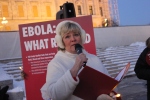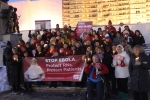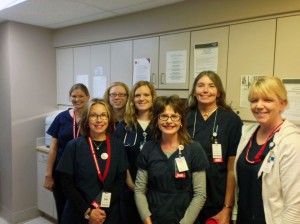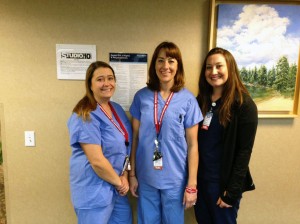The new law regarding mandatory continuing education of child abuse for health care licensee reporters in Pennsylvania will take effect in 2015. The Pennsylvania State Nurses Association (PSNA) has created resources for registered nurses in the Commonwealth. The PSNA Department of Government Affairs and the PSNA Department of Professional Development have partnered to create education for licensed nurses as well as nursing students preparing to graduate. This education is currently under review for approval by the State Department but should be released by January 2015 when the new law takes effect. To learn more, contact PSNA Director of Professional Development Dr. Aislynn Moyer at amoyer@psna.org.
Monthly Archives: November 2014
Ebola Preparedness – What National Nurses United Won in California
The state of California, at the insistence of registered nurses, has set an Ebola safety standard for the nation. In the face of the disease known as “nurse killer,” CNA/NNU has defeated efforts by the hospital industry to limit the protection of nurses to the voluntary, unenforceable guidelines put forth by the Centers for Disease Control. Instead, we have collectively ensured an optimal standard for personal protective equipment (PPE) and respiratory protection that will enable nurses to safely treat Ebola patients.
- For any nurse in direct contact with a suspected or confirmed Ebola patient, mandatory, enforceable requirements under Cal-OSHA on hospitals, including emergency departments, to provide coverall PPE full-body suits, along with nitrile gloves and non-slip cover boots;
- Requirement that hospitals provide a powered air-purifying respirator (PAPR) with a full hood or cowl for any nurse in contact with a suspected or confirmed Ebola patient;
- PPE and PAPR requirements apply to employees providing care to suspected or confirmed Ebola patients, employees cleaning contaminated areas, and staff assisting employees with the removal of contaminated protective gear in all hospital departments, including the ER;
- All PPE must meet or exceed the NNU-supported ASTM standards on blood and blood-borne pathogen penetration;
- Continuous, hands-on interactive training is required for nurses and other healthcare workers, with demonstrated competency, on donning and doffing, transmission, and other procedures, before treating any suspected or confirmed Ebola patient. Computer-based learning does not meet the training requirement;
- Hospitals are required to actively involve nurses in the development of the exposure control plan;
- Nurses have the protected right to express their health and safety concerns without fear of retaliation, and hospitals must investigate and report back on any reported concern;
- Nurses exposed to potential infection may be relieved of work duties, or placed in an alternative job, but otherwise must receive full pay and preserve all benefits and seniority rights until incubation period ends and they are returned to their original position.
Nurses can enforce this guidance under their union contract through their professional practice committee (PPC) or by taking other collective action against hospital management. Cal-OSHA is the state agency that enforces these standards and will investigate complaints made directly to them at the Cal-OSHA district office closest to the workplace (list of offices here: www.dir.ca.gov/dosh/DistrictOffices.htm). Nurses can also file whistle-blower complaints about inadequate patient safety and non-compliance with these standards to the California Department of Public Health, which licenses hospitals.
How did NNU win new Ebola and infectious disease safety requirements to protect nurses?
Overcoming lobbying by Kaiser and other hospitals, CNA/NNU fought to establish stronger enforceable standards for personal protective equipment (PPE), including respiratory protection, training, and medical services. Kaiser Permanente, the largest healthcare corporation in the United States, led the fight by the healthcare industry against stronger patient safety requirements. They only wanted voluntary guidelines or multiple-choice options that would leave it up to them and their budget as to how nurses were protected. Kaiser unabashedly took this position notwithstanding the overwhelming public health consensus that healthcare workers in direct contact with Ebola patients have been identified as being at increased risk of contracting the disease.
This is a tremendous victory. It is a demonstration of our power and demonstration of why nurses must fight hard for improved patient care conditions. It is a precedent-setting victory for disaster preparedness now and in the future.
Which regulations and standards for Ebola preparedness apply to my facility?
The federal Centers for Disease Control (CDC) issues guidelines that U.S. hospitals often rely upon, but they are voluntary and not enforceable. By contrast, the new California standards requiring hospitals to protect employees against exposure to Ebola virus disease are enforced by the state Division of Occupational Safety and Health, commonly known as “Cal-OSHA.” For Ebola, these regulation sections cover: Blood-borne pathogens (BBP); Aerosol Transmission Diseases (ATD – unique to California); Personal protection of the body, eyes, nose, and mouth; Respiratory Protection, and Injury and Illness Prevention Program.
What are the specific requirements California hospitals must meet?
Employees must use PPE that is a full-body suit and covers all surfaces of the body so that absolutely no skin is exposed. The entire PPE must meet or exceed the ASTM standards for blood or bloody fluid penetration F1670 and F1671 for blood-borne pathogens penetration. In addition, the Cal-OSHA ATD standard requires powered air-purifying respirators – PAPRs with a long hood or cowl. PPE and PAPR requirements apply to employees providing care to suspected or confirmed Ebola patients, employees cleaning contaminated areas, and staff assisting employees with the removal of contaminated protective gear in all hospital departments, including the ER. The burden of proving no risk for exposure to aerosol-generating activity or events falls upon the employer.
Specifically, the PPE must be a full-body suit that prevents the penetration of fluids from reaching an employee’s clothing, undergarments, skin, eyes, mouth, or other mucous membranes; the head and neck must be protected, including coverings for the eyes, mouth, nose, and skin, the hair must be completely enclosed; include two or more pairs of nitrile gloves; undersocks (or equivalent protection) integrated into the coverall with fluid-protective boots or coverings over the feet and lower legs that prevent slipping; it must be reasonably comfortable and not impede necessary movements.
For Emergency Departments, the guidance says, “If isolation and transfer procedures and protocols, along with engineering and work practice controls, are insufficient to prevent employee exposure, the employer must ensure that employees at risk of exposure use appropriate PPE including respiratory protection…”
How is the hospital required to conduct training on PPE and procedures?
Under the new Cal-OSHA enforceable standards, hospitals must fully train and supervise employees with the donning, doffing, and use of PPE. Employees must be fully capable of donning and doffing. The donning and doffing of full-body protection requires assistance. Employees assisting in removing contaminated PPE must also use their own PPE, including a PAPR. Hospitals must assure that the trained employee understands the content of the training and can correctly perform the required tasks. Employees must be given an opportunity for interactive questions and answers with the person conducting the training on the BBP and ATD standards. Hospitals must also ensure that employees can demonstrate how to put on, use, and remove PPE and respirators. This requires hands-on practice sessions. Training that only uses printed materials or computer-based learning does not satisfy the training requirement.
Should the hospital designate distinct areas to limit exposure?
Yes, to avoid exposing employees to infectious materials, hospitals must designate three distinct areas: 1) a clean area for donning clean PPE, 2) the patient care area, and 3) a decontamination area where an employee can progressively remove the PPE. And readily accessible hand-washing areas.
Is my hospital required to have an exposure control plan that involve nurses?
In California, yes. Each plan must include an effective procedure for obtaining the active involvement of employees at risk of exposure in reviewing and updating the exposure control plan, and no plan is valid without the hospital requesting and considering employee input.
Am I protected if I report problems with Ebola preparedness in my facility?
California law provides that no health facility can discriminate or retaliate in any manner against any patient or employee of the health facility because that patient or employee or any other person has presented a grievance or complaint, or has initiated or cooperated in any investigation or proceedings of any governmental entity, relating to the care, services, or conditions of that facility. The Cal-OSHA Injury and Illness Prevention Program standard requires that employers institute a comprehensive health and safety program that addresses all potential hazards and encourages employees to report hazards without fear of reprisal.
What if my hospital says they cannot obtain the needed PPE?
To address a potential shortage of PPE for U.S. hospitals treating Ebola-infected patients, the CDC has obtained a limited number of kits that will help address short-term PPE needs. Purchases include impermeable coveralls and aprons; boot covers; gloves; face shields and hoods; powered air-purifying respirator systems and ancillaries; and disinfecting wipes.
What happens if I am exposed to the Ebola virus?
If an employee experiences an exposure incident, they must be sent to a physician or licensed healthcare provider for evaluation and medical follow-up, which follows the CDC guidelines for medical services. If determined as possibly infectious, the employee may be removed from employment during the incubation period. If permitted, the employee may be assigned alternate work. Otherwise, per the Cal-OSHA requirements, the employee’s earnings, seniority, and all other rights and benefits must be maintained during that period, and the employee restored to her normal position when the period is over.
Can I get better pay on Travel Nursing assignments?

Ask a Travel Nurse: Can I get better pay on Travel Nursing assignments?
Ask a Travel Nurse Question:
I’ve been a nurse for 10 years and am very strongly considering switching to Travel Nursing. I currently work as a float nurse throughout a 1000-bed Missouri hospital specializing in NICU/Peds/PICU. I make $31 per hour, and do OK because I work premium shifts about once a week bringing my take home pay about $1000 a week, after taxes and insurance.
My biggest motivator for trying Travel Nursing is pay. I have a lot of education debt and need to make more to manage it. Do you think with my background and experience I can do better financially as a Travel Nurse than I am now? Can I consistently get better pay on Travel Nursing assignments?
Ask a Travel Nurse Answer:
Whenever someone mentions money as their motivation for Travel Nursing, I discourage it because I believe that most anywhere in the country you should be able to make as much money as you want with per diem and agency work. And while you can ask your recruiter to only submit you for jobs offering over “x” amount per hour, I cannot promise you that those jobs will be prevalent on a continual basis.
However, I will say that $31 seems low for NICU/PICU and you very well could find some decent paying assignments out there. As a Travel Nurses, you could also pocket some extra money living on the cheap while taking a housing stipend (however, you need to be sure you understand the tax implications of housing stipends and if you even qualify for that reimbursement to be considered tax exempt).
The short answer is, I cannot assure you that you would make more financially in travel. For many people the value of the experience factors in as well.
But, if you would like to speak to some great Travel Nurse resources, I do always offer to set people up with the recruiters I use and trust with my travels. If you like, send me your preferred email address and current phone number to david@travelnursesbible.com. I will forward this info to my recruiters and then email you with the names of the people who will be contacting you and a little bio on the company for which they work. I ONLY share this info with the five recruiters to whom I refer people.
They are all great with new Travelers and will take the time to give you some numbers of the going rates of current assignments throughout the U.S. and you can then see if the financials work out for you. Also if you do email me, just remind me briefly of your situation. I have a pretty good memory, but do correspond with quite a few Travel Nurses.
David
State Health Insurance Exchanges Hope To Woo Urban Minorities
Tomorrow it begins again – open enrollment for Obamacare. Two very successful state health insurance exchanges, Connecticut’s and California’s, are both intent on reaching people who avoided signing up last year – especially young Latinos and African-Americans.
“The big takeaway for us last year was that the uninsured were really pocketed in a couple of key, large cities,” says Jason Madrak, the chief marketing officer of Access Health CT, in Connecticut. In light of that, he says, the exchange has changed its ad strategy.
“We’ve dialed up some of the more locally-focused efforts while we’ve dialed down some of the broader efforts,” he says.
The uninsured people Madrak’s trying to reach tend to be young, male, urban and Hispanic or African American. They also “aren’t really consumers of traditional media,” he says.
They don’t necessarily read the big daily newspapers and they don’t watch mainstream TV, so they can be harder to reach. So Madrak is spending his media money on ads in community newspapers and on local television and radio.
Reaching potential customers is the first half of the job. The second half is figuring out what to tell them. One emphasis is on money, like in this TV ad with a barber asking his customer if he has health insurance. When the customer says, “No, I can’t afford it,” the barber says, “Now, you can, with Access Health CT, since you may qualify for help to pay for your coverage.”
Madrak says the messages of ads that appear later in the open enrollment period, as people are starting to think harder about choices, will be more specific about the cost of the insurance.
“If I say ‘affordable,’ nobody really knows what that means,” he says. “If I say, ‘I can get you a plan for 20 bucks a month with tax credits,’ that means something to somebody at that point.”
California health officials are also deploying a new and (they hope) improved campaign to woo Latinos. Last year, Covered California made a series of missteps. First, the exchange had only a handful of Spanish-speaking counselors at the call centers. And the Spanish advertising campaign was riddled with cultural oversights.
Among the worst gaffes: Some Latinos who worried that signing up would get undocumented relatives in trouble were shown a written promise from President Obama to the contrary – a note that, unfortunately, was printed on letterhead of U.S. Immigration and Customs Enforcement.
Covered California says it has learned from those mistakes. Peter Lee, the executive director, says this year, the agency is doubling down on making sure Latinos get the right messages.
“We’re actually spending more money on outreach, education, and marketing this year for a three-month period than we spent for six months last year,” he says.
The agency has hired 200 new call center counselors who speak languages other than English, Lee says. It is enlisting more trusted community organizations to allay fears about deportation. And it’s rolling out a new ad campaign tailored specifically to Latinos.
“Every person you see [in these advertisements] that is a Spanish speaker is a Latino who got coverage through Covered California this last year, and it made a difference in their lives,” says Lee.
This new video commercial shows pages of immigration documents flying into a safety vault – accompanied by verbal assurances that the application process is confidential.
But the main challenge, Lee says, is persuading Latinos to buy something they don’t believe they need or is worth the price.
“They’ve adjusted to a culture of coping,” he says. “We need to go from a culture of coping to a culture of coverage.”
Still, a woman in a recent focus group in Connecticut showed Madrak that even the best messages might not work.
“She said, ‘Listen, I saved everything that you guys sent me,’ ” Madrak says. ” ‘I have a box of postcards and letters that you sent me because it has the phone number on it and I wanted to save it.’ And we said, ‘Did you call?’ And she said, ‘No, I never called.’ And we said, ‘But you saved it all!’ And she said, ‘I know, I knew it was important; I just never got around to actually doing it.’ “
That, Madrak says, is the big, continuing challenge.
Open enrollment runs from Saturday, Nov. 15 through Feb. 15, 2015.
This story is part of a reporting partnership that includes WNPR, KQED, NPR and Kaiser Health News.
Kaiser Health News (KHN) is a national health policy news service. It is an editorially independent program of the Henry J. Kaiser Family Foundation.
HPC to Hold Second Listening Session: Nurse Staffing in ICUs on Nov. 19 from 9 – 11 a.m. at State House in Boston
Attention ICU nurses, below is an announcement from the State’s Health Policy Commission about a second listening session about the new law for safe limit…
Nurses vow to file OSHA complaints over Ebola preparedness
Nurses and other healthcare workers urged the state to live up to its responsibility to protect front-line healthcare workers dealing with Ebola and other infectious diseases at a Nov. 12 rally and candlelight vigil on the front lawn of the State Capitol.
Nurses and other healthcare workers spoke about their experiences and concerns about their hospitals’ different levels of preparedness for caring for patients who may have infectious diseases like Ebola.
“At my hospital, we do have some equipment and we have had some training – but it’s just not enough,” said Gail Olson, RN at Unity Hospital. “Nurses keep asking the hospital for more because we know what we have is too little. Nurses want to care for every patient – with Ebola, any infectious disease – any health problem. We just need to know we have the equipment and training to safely care for our patients.”
“We’re calling on government and hospitals to do the right thing: Provide the optimal equipment, training and staffing and we’ll be able to deal with anything,” said National Nurses United Co-President and Minnesota nurse Jean Ross. “We just need to be sure we can do it safely – and go home to our families knowing we’re not putting them in danger – or our neighbors and communities.”
“The state of Minnesota needs to set a standard for hospitals that protects everybody,” said Mary McGibbon, RN at Methodist Hospital and MNA first vice president. “The state needs to enforce OSHA guidelines on bloodborne diseases that are already in place. If I’m not protected, my patients aren’t protected either.”
McGibbon called on nurses who believe their hospitals are not prepared to file complaints with Minnesota OSHA. “You have a right to file and complaint and ask them to come to your hospital to see if the equipment and preparedness plan meet federal and state law.
The rally and candlelight vigil were part of the National Day of Ebola Preparedness, when thousands of nurses and other healthcare workers across the country are holding public events to demand optimal protective equipment, training, and staffing to make sure healthcare workers are safe as they care for their patients.
View a video from the event here.
Yeah, This is why I’m in nursing school – So I can pass trays
Yesterday I overheard a nursing student snark, “Yeah, this is why I’m in nursing school – so I can pass trays.” The following was posted by an Anonymous Facebook User… Her words resonated with me intensely. Her thoughts echoed the same words that I’ve whispered in my thoughts many times, and not simply in response […]
The post Yeah, This is why I’m in nursing school – So I can pass trays appeared first on The Gypsy Nurse.
With Tight Enrollment Window, Consumers Seeking Coverage Should Sign Up Promptly
Smooth sailing. The administration promises and outside experts expect that this year’s open enrollment period on the health insurance marketplaces will be markedly less glitchy and balky than last. Consumers will begin to find out if that’s true tomorrow when the marketplaces open for 2015 coverage.
But even if enrollment goes smoothly this year, consumers shouldn’t be complacent about reviewing their options online to sign up for or renew their coverage, say experts. The three-month sign-up window that closes Feb. 15 is half as long as last year’s, and if consumers want coverage to begin Jan. 1 they need to sign up much earlier than that, by Dec. 15. So if you’re planning to shop, get cracking.
As of October, there were 7.1 million people enrolled in the health insurance marketplaces, according to the Department of Health and Human Services. Earlier this week, HHS estimated that 9 to 9.9 million will be enrolled in 2015. That figure is significantly lower than the 13 million projected by the Congressional Budget Office in April.
In 2015, approximately 315 insurers will offer coverage on the health insurance marketplaces, roughly 25 percent more than this year, according to preliminary data from 44 states published by HHS in September.
But those figures don’t tell the whole story.
“There are still rural areas where there is a real dearth of plans,” says Caroline Pearson, vice president at Avalere Health, a research and consulting firm.
And more insurers doesn’t necessarily mean more plans. In Florida, for example, the number of insurers on the marketplace will increase from 11 in 2014 to 14 next year, but the number of available plans will actually decline, from 352 to 278, according to data from the Florida Office of Insurance Regulation.
But choice is a two-edged sword, according to Sabrina Corlette, project director at the Georgetown Center on Health Insurance Reforms. “Most behavioral economics studies tell us that consumers are overwhelmed by too much choice and make less than optimal decisions as a result,” says Corlette.
Premium increases in 2015 should be modest for most people, and in many cases may decline slightly.
The average premium for a 40-year-old non-smoker who makes $30,000 a year will decline by 0.2 percent next year if he buys the second lowest cost silver plan, according to an analysis by the Kaiser Family Foundation of 2015 marketplace premiums in a major city in 47 states and the District of Columbia. (KHN is an editorially independent program of the foundation.) Individual state rates for this person would deviate substantially from the average, however, from a 28.4 percent increase in Anchorage, Alaska, to a 23.7 percent decline in Jackson, Miss.
The premium tax credit available to people with incomes between 100 and 400 percent of the federal poverty level ($11,670 to $46,680 for an individual) minimizes the effect of premium increases on people’s costs. But subsidies are tied to the second-lowest-cost silver benchmark plan, and in a number of areas that plan will change in 2015. When that happens, people may face substantial premium increases unless they take the time to shop and make sure they’re still in a low-cost plan.
“You may be able to insulate yourself against a big premium increase, but you still need to go in and change plans,” says Judith Solomon, vice president for health policy at the Center on Budget and Policy Priorities.
Consumers who are already enrolled in a marketplace plan and who do nothing during open enrollment this year will generally be automatically re-enrolled in their existing plan for next year with their existing premium tax credit, the federal government has said.
Consumer advocates say doing nothing could be a big mistake. Not only are benchmark plans different, if consumers have experienced changes in income or other circumstances that could affect their premium tax credit, they risk receiving the wrong amount and may have to pay back next year.
People who are already enrolled may not get the best deal if they don’t shop for a new plan, but at least they’ll have insurance. That’s not the case for the estimated 15 million uninsured people who are eligible to buy a marketplace plan. Reaching them is going to be a challenge, experts agree. They’re more likely to be younger, members of minority groups, lower income and less educated, says Anne Filipic, president of Enroll America. The organization’s Get Covered America campaign aims to get enrollment information to people in 11 states with high rates of uninsurance, among other things.
They have their work cut out for them. Nine out of 10 uninsured people said they don’t know when the open enrollment period starts, according to the Kaiser Family Foundation’s October health tracking survey. Two thirds said they knew nothing or practically nothing about the marketplaces, and more than half didn’t know that they could get financial help to pay for their coverage.
Please contact Kaiser Health News to send comments or ideas for future topics for the Insuring Your Health column.
Kaiser Health News (KHN) is a national health policy news service. It is an editorially independent program of the Henry J. Kaiser Family Foundation.
MNA welcomes Bemidji Clinic nurses
Nurses at Sanford Bemidji Clinic are now part of the Minnesota Nurses Association, after a five-month campaign to be part of the union.
The nurses knew the value of belonging to a union, and campaigned hard for representation. They wore “Union Now” stickers and marched a petition to management to show they were standing strong for union representation and a voice in the workplace.
Nurses at the Sanford Bemidji Medical Center, who are already MNA members, circulated petitions expressing their support of clinic nurses becoming part of their bargaining unit.
“We wanted a voice in our workplace,” said bargaining team member Emily Westover. “The hospital nurses were already part of MNA, and clinic nurses wanted the same voice and representation. It made sense to be part of the same union.”
Westover said the move guarantees that good patient care at the clinic will continue.
“We’re opening a new chapter and creating more opportunity,” said Westover. “I want future nurses to have what I didn’t have – and make it better for everyone else.”
“I am so excited for the whole group of clinic nurses who have come together to show our strength,” said bargaining team member Christine Sheikholeslami. “We are also very fortunate to have the hospital nurses being so supportive. As nurses, our first priority has always been the health and safety of our patients. Having the collective strength of the union keeps this goal in the forefront. We must also see that nurses are adequately compensated. We want to help make sure that people who make nursing their career, will continue to love what they do and want to stay in this field.”
The new bargaining unit has been accreted into the hospital nurses’ contract and will now negotiate a separate wages-and-hours package with Sanford. When the contract expires in 2017, the hospital and clinic nurses will all bargain together as one strong unit.
Starting tomorrow, consumers can once again shop for coverage through the Health Insurance Marketplace
Starting tomorrow, consumers can once again shop for coverage through the Health Insurance Marketplace.









